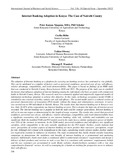Internet Banking Adoption in Kenya: The Case of Nairobi County

View/
Date
2012-09Author
Njuguna, Peter Kamau
Ritho, Cecelia
Olweny, Tobias
Wanderi, P Mwangi
Type
ArticleLanguage
enMetadata
Show full item recordAbstract
The adoption of Internet banking as a platform for carrying out banking services has continued to rise globally.
This can be attributed to a number of factors such as perceived usefulness, perceived ease of use, self-efficacy,
relative advantage, compatibility, and result demonstrability. This paper is based on findings of an MBA study
that was conducted in Nairobi County, Kenya between 2010 and 2011. The purpose of the study was to establish
the factors that influence adoption of internet banking among the individuals who have accounts with commercial
banks in Nairobi County, Kenya. This research used two commonly applied and empirically supported models of
information technology adoption to achieve this objective. In this study, technology acceptance model (TAM) is
extended by two external variables, namely risk and self-efficacy. The second model used is a reduced version of
perceived characteristics of innovation (PCI) model, without the image and voluntariness constructs. A survey
was carried out on 300 individuals in Nairobi, Kenya. The results show that internet banking use in Kenya is very
low. Only 24.82% of the respondents use Internet banking services. This is despite the high rate of internet access
recorded. The internet banking use is popular to both the male and the younger generations. Internet banking is
still at its nascent stages as demonstrated by the length of usage response. The results also reveal that perceived
usefulness, perceived ease of use, self-efficacy, relative advantage, compatibility, and result demonstrability have
a significant association with intention to use internet banking, while risk, visibility and trialability are not
significant. Both the modified TAM and PCI models used in the study have a similar explanatory power of slightly
over 20% of the variance in intention. In the TAM model, perceived usefulness and self-efficacy are significant
variables, while compatibility is the only variable significant for the PCI model. Further, results indicate that
users’ perceptions of various aspects of internet banking are more positive than non-users’ perceptions, except
for risk. Although risk is found to be insignificant in this study, considering results of prior studies, further studies
are required to examine its influence on intention. The study recommends that, banks should consider launching
campaigns to demonstrate the usefulness and benefits of internet banking as a promotional and marketing
measure. Additionally, banks must make a continuous effort to understand consumers’ requirements and design a
delivery of their products and services in such a way that it is consistent with customers’ requirements, beliefs
and the way customers are accustomed to work. Banks websites should facilitate customers with a ‘one stop
comprehensive financial’ service. As well as arranging for a hands-on training for prospective users to enhance
their self-efficacy.
Citation
International Journal of Business and Social Science ; 3 (18 ), Special Issue, 2012Publisher
Department of Agricultural Economics, University of Nairobi, Kenya
Description
Journal article
